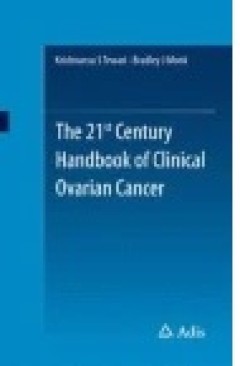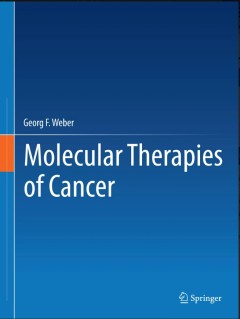Filter by

Tumor Cell Metabolism Pathways, Regulation and Biology
The four sections of this book cover cell and molecular biology of tumor metabolism, metabolites, tumor microenvironment, diagnostics and epigenetics. Written by international experts, it provides a thorough insight into and understanding of tumor cell metabolism and its role in tumor biology. The book is intended for scientists in cancer cell and molecular biology, scientists in drug and diagn…
- Edition
- -
- ISBN/ISSN
- 978-3-7091-1824-5
- Collation
- 17 b/w illustrations, 35 illustrations in colour
- Series Title
- -
- Call Number
- -

Roles of NF-κB in Cancer and Their Therapeutic Approaches
Although mortality rates have declined in recent years, the majority of cancers are still difficult to treat and the medical need for better cancer treatment is evident. The current anticancer armamentarium includes many active agents that are applied across tumor types. However, most of these broadly-active anticancer drugs have a small therapeutic index and barely discriminate between maligna…
- Edition
- -
- ISBN/ISSN
- -
- Collation
- -
- Series Title
- -
- Call Number
- 616 ROL

Stereotactic Body Radiotherapy A Practical Guide
This is a single, comprehensive handbook for clinical oncology trainees and consultants, covering the basic aspects of stereotactic radiotherapy systems and treatment.“This is an excellent book regarding the stereotactic radiation modality include focused beam, stereotactic treatment of head and neck cancers, brain tumors, Cranial and Spinal AVMs, as well as GI/Pancreas tumors, liver, prostat…
- Edition
- 1
- ISBN/ISSN
- 978-0-85729-597-2
- Collation
- -
- Series Title
- 8 b/w illustrations, 51 illustrations in colour
- Call Number
- X, 332

Stereotactic Body Radiation Therapy Principles and Practices
This book serves as a practical guide for the use of stereotactic body radiation therapy in clinics. On the basis of more than 10 years of clinical experience with lung cancer, liver cancer and other cancers, a remarkable volume of knowledge has been accumulated. At the same time, great progress in techniques has been achieved. Various new fixing apparatuses, new respiratory regulation techniqu…
- Edition
- 1
- ISBN/ISSN
- 978-4-431-54883-6
- Collation
- -
- Series Title
- 21 b/w illustrations, 55 illustrations in colour
- Call Number
- XII, 254

Eye Pathology An Illustrated Guide
This book is a comprehensive, in-depth, and up-to-date resource on eye pathology that will be of great practical value for ophthalmic and general pathologists and ophthalmologists. Congenital abnormalities, inflammatory conditions, infections, injuries, degenerative diseases, and tumors are all covered with the aid of more than 700 images. In the case of tumors, the wide variety of neoplasms th…
- Edition
- -
- ISBN/ISSN
- 978-3-662-43382-9
- Collation
- 20 b/w illustrations, 716 illustrations in colour
- Series Title
- -
- Call Number
- -

Advances in Cancer Survivorship Management
This volume presents the MD Anderson experience in providing care and services to the rapidly growing population of cancer survivors, which is currently estimated to be 12 million in the United States and more than 25 million worldwide. As cancer survival rates have increased, it has slowly become clear that the challenges faced by people with cancer do not end with treatment but simply change.…
- Edition
- Ed. 1
- ISBN/ISSN
- 978-1-4939-0985-8
- Collation
- XIV, 460
- Series Title
- MD Anderson Cancer Care Series
- Call Number
- 616.994 ADV a

Advances in Cancer Biomarkers: From biochemistry to clinic for a critical rev…
At present there are a growing number of biomolecules under investigation to understand their potential role as cancer biomarker for diagnostic, prognostic and therapeutic purposes. Intriguingly, the state of art on cancer biomarkers research shows interesting and promising results together to clamorous failures. Also from a clinical point of view, there are contradictory results on routine cl…
- Edition
- Ed. 1
- ISBN/ISSN
- 978-94-017-7215-0
- Collation
- IX, 372
- Series Title
- Advances in Experimental Medicine and Biology
- Call Number
- 616.994 ADV a

Tropical Hemato-Oncology
What should you do when you have restricted resources? Written by the most prominent experts from the North and the South countries, this book offers a unique complement to classical hematology and oncology textbooks focusing on specific issues concerning cancers in tropical areas. It presents a thorough review of the specific biological, clinical and therapeutic characteristics of cancers in t…
- Edition
- 1
- ISBN/ISSN
- 978-3-319-36373-8
- Collation
- XXIII, 562
- Series Title
- -
- Call Number
- -

The 21st Century Handbook of Clinical Ovarian Cancer
A thorough review on ovarian cancer, treatment guidelines and emerging therapies available for the disease. The book was originally commissioned due to recent developments in therapies for ovarian cancer. This concise pocket book will review ovarian cancer’s epidemiology, clinical features, diagnosis and medical management. Busy healthcare professionals will benefit from this text, which will…
- Edition
- -
- ISBN/ISSN
- 978-3-319-08066-6
- Collation
- XVI, 200
- Series Title
- -
- Call Number
- -

Molecular Therapies of Cancer
Molecular Therapies of Cancer comprehensively covers the molecular mechanisms of anti-cancer drug actions in a comparably systematic fashion. While there is currently available a great deal of literature on anti-cancer drugs, books on the subject are often concoctions of invited review articles superficially connected to one another. There is a lack of comprehensive and systematic text on the t…
- Edition
- 1
- ISBN/ISSN
- 978-3-319-13277-8
- Collation
- XV, 488
- Series Title
- -
- Call Number
- -
 Computer Science, Information & General Works
Computer Science, Information & General Works  Philosophy & Psychology
Philosophy & Psychology  Religion
Religion  Social Sciences
Social Sciences  Language
Language  Pure Science
Pure Science  Applied Sciences
Applied Sciences  Art & Recreation
Art & Recreation  Literature
Literature  History & Geography
History & Geography